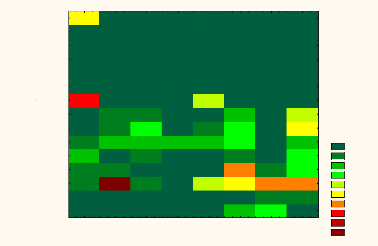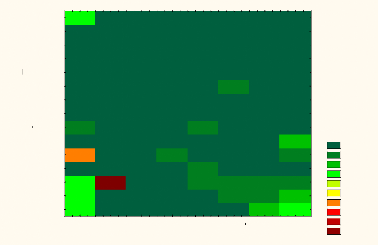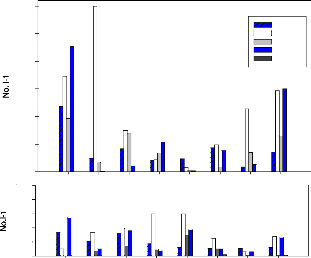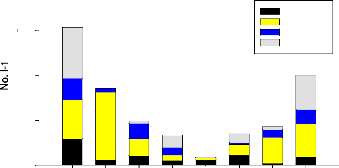3.1.2 Zooplankton
The zooplankton community investigated was represented by the
freshwater common groups, the crustacean cladocerans and copepods (Cyclops and
Calanoids) and rotifers. A few individuals belonging to the Ostracods group
were also recorded. The zooplankton community was dominated in February by
copepods (Table 3.9); Cyclopes having 28.6 % followed by their youngsters
(Nauplii) with 15.2%, the rotifer Keratella (14.2%) and copepod
Calanoids nauplii (13%). Communal lands had the highest zooplankton abundance
in both February and April samples with respectively 63% and 57%. The Cyclopes
were again dominant in April with 27 % of the total abundance followed their
nauplii, a cladoceran species, the rotifers Keratella and
Brachionus all getting ca. 10%.
Table 3.9. Abundance of zooplankton (no.l-1) for the
samples of February and April
|
Taxa (February)
|
Communal lands National Park
|
Abundance
|
%
|
|
Daphnia
|
109
|
18
|
127
|
6.3
|
|
Moina
|
68
|
67
|
134
|
6.6
|
|
Ceriodaphnia
|
14
|
0
|
14
|
0.7
|
|
Simocephalus
|
2
|
0
|
2
|
0.1
|
|
Bosmina
|
11
|
2
|
13
|
0.6
|
|
Chydorus
|
3
|
24
|
27
|
1.3
|
|
Cyclops
|
447
|
133
|
580
|
28.6
|
|
calanoida
|
59
|
5
|
64
|
3.1
|
|
nauplius calanoida
|
157
|
105
|
262
|
12.9
|
|
nauplius cyclopoida
|
123
|
185
|
309
|
15.2
|
|
Brachionus
|
32
|
44
|
76
|
3.7
|
|
Keratella
|
235
|
50
|
286
|
14.1
|
|
A (long avec queue)
|
26
|
84
|
110
|
5.4
|
|
X (Rotifera)
|
0
|
26
|
26
|
1.3
|
|
Leptodora
|
0
|
2
|
2
|
0.1
|
|
Total
|
1286
|
745
|
2031
|
|
|
%
|
63.3
|
36.7
|
|
|
|
Taxa (April)
|
|
|
Daphnia
|
34
|
2
|
36
|
5.3
|
|
Moina
|
32
|
2
|
34
|
5.0
|
|
Cladocera indet
|
36
|
43
|
80
|
11.8
|
|
Brachionus
|
36
|
25
|
61
|
8.9
|
|
Microdides
|
22
|
28
|
50
|
7.3
|
|
Keratella
|
48
|
20
|
68
|
10.0
|
|
Rotifera indet
|
3
|
5
|
8
|
1.1
|
|
Cyclops
|
119
|
63
|
182
|
26.8
|
|
calanoida
|
9
|
8
|
18
|
2.6
|
|
nauplius calanoida
|
22
|
34
|
56
|
8.2
|
|
nauplius cyclops
|
24
|
56
|
80
|
11.8
|
|
Macrothrix
|
1
|
0
|
1
|
0.2
|
|
Ceriodaphnia
|
1
|
0
|
1
|
0.2
|
|
Ostracoda indet
|
0
|
3
|
3
|
0.5
|
|
Lepadella
|
0
|
2
|
2
|
0.3
|
|
Total
|
386
|
292
|
678
|
|
|
%
|
56.9
|
43.1
|
|
|
There was no significant difference in species composition for
the student's t-test between communal lands and National Park in February
(t=1.41; P=0.17; df=14) and in April samples (t = 1.13; P = 0.27; df = 14).
Seasonal differences in zooplankton distribution and abundance
were seen in both the
communal lands and National Park (Figure 3.3, Figure
3.4, Table 3.10 and Table 3.11).
Copepods (composed of Cyclopoids and
Calanoids) dominated the samples, comprising

Cladocera indet.
Nauplius Cycl
Rotifera indet.
Ceriodaphnia
Nauplius cal
Brachionus
Microdides
Macrothrix
Ostracoda
Lepadella
Keratella
Calanoid
Cyclops
Daphina
Moina
SIBASA MEZILUME MPOPOMA DENJE
MAKOSHE CHITAMPA DEWA
MALEME
4.799 9.598 14.396 19.195 23.994 28.793 33.591 38.39 43.189
47.988
60% of total zooplankton abundance in February and 49 % in
April. Ostracods were not found in February samples. Few Ostracods were
recorded in April in Chitampa reservoir and Maleme reservoir, both located in
the Matopos National Park (Table 3.9).

Rotifera(indet2)
Rotifera(indet1)
Simocephalus
Nauplius cycl
Ceriodaphnia
Nauplius cal
Brachionus
Leptodora
Chydorus
Keratella
Bosmina
Calanoid
Cyclops
Daphnia
Moina
SIBASA
DENJE
MALEME
MAKOSHE
MEZILUME
DEWA
CHITAMPA
MPOPOMA
26.701 53.402 80.103 106.804 133.505 160.206 186.906 213.607
240.308 267.009
Fig. 3.3. Zooplankton species distribution and abundance (numbers
of zooplankton per litre in the right) among the 8 reservoirs/ February
Fig. 3.4. Zooplankton species distribution and abundance (numbers
of zooplankton per litre in right) among the reservoirs/ April
Table 3.10. Abundance of major zooplankton groups/February
|
Taxa
|
Communal lands Reservoirs
|
National Park Reservoirs
|
Total
|
%
|
|
Siba
sa Dewa Denje Makoshe
|
Mpopo Chitamp Mezilum
ma a e Maleme
|
|
Cladocera
|
118
|
24
|
42
|
21
|
24
|
44
|
9
|
36
|
318
|
15.7
|
|
Cyclopoda
|
173
|
300
|
75
|
23
|
8
|
49
|
114
|
147
|
889
|
43.8
|
|
Calanoida
|
96
|
17
|
69
|
34
|
2
|
7
|
35
|
65
|
326
|
16.0
|
|
Rotifera
|
227
|
1
|
11
|
54
|
2
|
39
|
13
|
150
|
498
|
24.5
|
|
Total
|
613
|
342
|
197
|
133
|
36
|
139
|
171
|
398
|
2031
|
|
|
%
|
30.2
|
16.9
|
9.7
|
6.5
|
1.8
|
6.9
|
8.4
|
19.6
|
|
|
Table 3.11. Abundance of major zooplankton groups /April
|
Taxa
|
Communal lands Reservoirs
|
National Park Reservoirs
|
Total
|
%
|
|
Sibas
a Dewa Denje Makoshe
|
Mpopo
ma
|
Chita
mpa Mezilume
|
Maleme
|
|
Cladocera
|
34
|
21
|
32
|
18
|
12
|
11
|
11
|
12
|
152
|
22.4
|
|
Cyclopoda
|
10
|
33
|
39
|
60
|
60
|
25
|
6
|
28
|
262
|
38.6
|
|
Calanoida
|
0
|
7
|
14
|
9
|
30
|
10
|
1
|
1
|
73
|
10.8
|
|
Rotifera
|
54
|
10
|
36
|
7
|
37
|
10
|
6
|
26
|
188
|
27.7
|
|
Ostracoda
|
0
|
0
|
0
|
0
|
0
|
2
|
0
|
1
|
3
|
0.5
|
|
Total
|
98
|
71
|
122
|
94 140
|
59
|
25
|
68 678
|
|
|
%
|
14.5
|
10.5
|
18.0
|
13.9 20.6
|
8.7
|
3.7
|
10.1
|
|
Sibasa reservoir recorded the highest abundance of zooplankton
in February (30%) followed by Maleme (20%) and Dewa (17%) while the highest
abundance in April was found in Mpopoma reservoir (21%) followed by Denje,
Sibasa and Makoshe. Fig. 3.5 and Fig. 3.6 highlight the differences in
abundance between February and April and among reservoirs. It is worth note
that Mpopoma had the lowest abundance of taxa in February (2%) and Mezilume had
the lowest abundance in April (4%). Fig. 3.5 also highlights the predominance
of Cyclopoids in February samples (in Dewa reservoir) followed by Rotifers.

April
100
80
300
250
200
150
100
50
0
February
C lad o Cyclo Calan Rotif Ostrac
Sib Dewa Denje Makosh Mpopo Chita Mezil Malem
60
40
20
0
Sib Dewa Denje Makosh Mpopo Chita Mezil Malem
Fig. 3.5 Zooplankton major groups abundance
Taxa abbreviations are: Cladocera (clado), Cyclopoids (Cyclo),
Calanoida (calan), Rotifer (rotif), Ostracoda (ostrac).
Reservoir abbreviations are: Sibasa (Sib), Makoshe (Makosh),
Mpopoma (Mpop), Chitampa (Chita), Mezilume (Mezil), Maleme (Malem)
800 Febru ary

400
200
600
0
Cladocera Cyclopoda Calanoida Rotifera
Sibasa Dewa Denje MakosheMpopomaChitampaMezilumeMaleme

200 April

150

100
50
0
Sibasa Dewa Denje MakosheMpopomaChitampaMezilumeMaleme
Fig. 3.6 Abundance of zooplankton major groups in the study
area
| 


